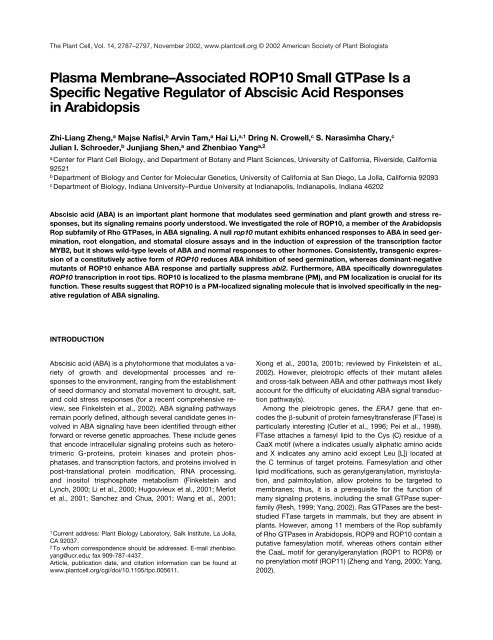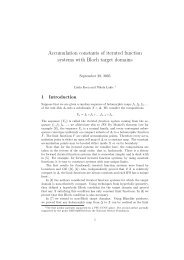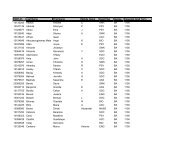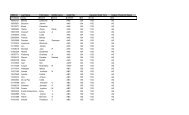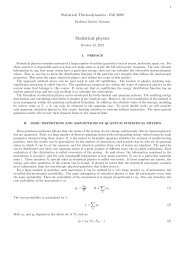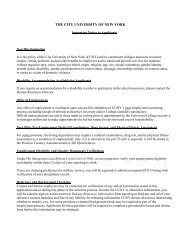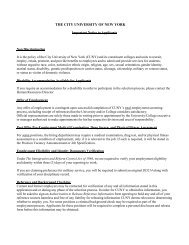Plant Cell 14
Plant Cell 14
Plant Cell 14
Create successful ePaper yourself
Turn your PDF publications into a flip-book with our unique Google optimized e-Paper software.
The <strong>Plant</strong> <strong>Cell</strong>, Vol. <strong>14</strong>, 2787–2797, November 2002, www.plantcell.org © 2002 American Society of <strong>Plant</strong> BiologistsPlasma Membrane–Associated ROP10 Small GTPase Is aSpecific Negative Regulator of Abscisic Acid Responsesin ArabidopsisZhi-Liang Zheng, a Majse Nafisi, b Arvin Tam, a Hai Li, a,1 Dring N. Crowell, c S. Narasimha Chary, cJulian I. Schroeder, b Junjiang Shen, a and Zhenbiao Yang a,2aCenter for <strong>Plant</strong> <strong>Cell</strong> Biology, and Department of Botany and <strong>Plant</strong> Sciences, University of California, Riverside, California92521bDepartment of Biology and Center for Molecular Genetics, University of California at San Diego, La Jolla, California 92093cDepartment of Biology, Indiana University–Purdue University at Indianapolis, Indianapolis, Indiana 46202Abscisic acid (ABA) is an important plant hormone that modulates seed germination and plant growth and stress responses,but its signaling remains poorly understood. We investigated the role of ROP10, a member of the ArabidopsisRop subfamily of Rho GTPases, in ABA signaling. A null rop10 mutant exhibits enhanced responses to ABA in seed germination,root elongation, and stomatal closure assays and in the induction of expression of the transcription factorMYB2, but it shows wild-type levels of ABA and normal responses to other hormones. Consistently, transgenic expressionof a constitutively active form of ROP10 reduces ABA inhibition of seed germination, whereas dominant-negativemutants of ROP10 enhance ABA response and partially suppress abi2. Furthermore, ABA specifically downregulatesROP10 transcription in root tips. ROP10 is localized to the plasma membrane (PM), and PM localization is crucial for itsfunction. These results suggest that ROP10 is a PM-localized signaling molecule that is involved specifically in the negativeregulation of ABA signaling.INTRODUCTIONAbscisic acid (ABA) is a phytohormone that modulates a varietyof growth and developmental processes and responsesto the environment, ranging from the establishmentof seed dormancy and stomatal movement to drought, salt,and cold stress responses (for a recent comprehensive review,see Finkelstein et al., 2002). ABA signaling pathwaysremain poorly defined, although several candidate genes involvedin ABA signaling have been identified through eitherforward or reverse genetic approaches. These include genesthat encode intracellular signaling proteins such as heterotrimericG-proteins, protein kinases and protein phosphatases,and transcription factors, and proteins involved inpost-translational protein modification, RNA processing,and inositol trisphosphate metabolism (Finkelstein andLynch, 2000; Li et al., 2000; Hugouvieux et al., 2001; Merlotet al., 2001; Sanchez and Chua, 2001; Wang et al., 2001;1Current address: <strong>Plant</strong> Biology Laboratory, Salk Institute, La Jolla,CA 92037.2To whom correspondence should be addressed. E-mail zhenbiao.yang@ucr.edu; fax 909-787-4437.Article, publication date, and citation information can be found atwww.plantcell.org/cgi/doi/10.1105/tpc.005611.Xiong et al., 2001a, 2001b; reviewed by Finkelstein et al.,2002). However, pleiotropic effects of their mutant allelesand cross-talk between ABA and other pathways most likelyaccount for the difficulty of elucidating ABA signal transductionpathway(s).Among the pleiotropic genes, the ERA1 gene that encodesthe -subunit of protein farnesyltransferase (FTase) isparticularly interesting (Cutler et al., 1996; Pei et al., 1998).FTase attaches a farnesyl lipid to the Cys (C) residue of aCaaX motif (where a indicates usually aliphatic amino acidsand X indicates any amino acid except Leu [L]) located atthe C terminus of target proteins. Farnesylation and otherlipid modifications, such as geranylgeranylation, myristoylation,and palmitoylation, allow proteins to be targeted tomembranes; thus, it is a prerequisite for the function ofmany signaling proteins, including the small GTPase superfamily(Resh, 1999; Yang, 2002). Ras GTPases are the beststudiedFTase targets in mammals, but they are absent inplants. However, among 11 members of the Rop subfamilyof Rho GTPases in Arabidopsis, ROP9 and ROP10 contain aputative farnesylation motif, whereas others contain eitherthe CaaL motif for geranylgeranylation (ROP1 to ROP8) orno prenylation motif (ROP11) (Zheng and Yang, 2000; Yang,2002).
2788 The <strong>Plant</strong> <strong>Cell</strong>The function of ROPs has been studied using transgenicexpression of constitutively active (CA) and dominant-negative(DN) mutants of ROPs (Yang, 2002). This approach hasimplicated two putative geranylgeranylation targets (ROP2and ROP6/AtRac1) in the negative regulation of ABA responses(Li et al., 2001; Lemichez et al., 2001), but dominantmutants of ROP2 and ROP6 also caused many otherphenotypes (Li et al., 2001; Molendijk et al., 2001; Fu et al.,2002; Jones et al., 2002). Recent studies using loss-of-functionmutants of Rac in Drosophila demonstrate that dominantmutants caused certain phenotypes unrelated to Racsignaling (Hakeda-Suzuki et al., 2002). Therefore, it is notclear whether the observed changes in ABA responses inducedby the dominant mutants of ROP2 and ROP6 reflecttheir function in ABA signaling.Here, we report the functional study of ROPs using a lossof-functionmutant. We show that a null mutation in ROP10specifically enhances various ABA responses and gene expressionand that the localization of ROP10 to the plasmamembrane (PM) is critical for its function. Together withdominant mutants of ROP10, our results provide genetic evidencethat ROP10 acts as a negative regulator of a PMassociatedABA signaling pathway.RESULTSThe rop10-1 Mutation Specifically EnhancesABA SensitivityTo test the possibility that ROP10 is an ERA1 target, we isolateda T-DNA insertional mutant of ROP10, designatedrop10-1. The rop10-1 mutant contains a T-DNA insertion atthe 5 end of the second exon that encodes the 36th aminoacid, Asp; thus, the mutation would likely truncate the conservedeffector domain, three GTP/GDP binding or GTP hydrolysisdomains, and the C-terminal membrane localizationmotifs (Zheng and Yang, 2000). Indeed, reverse transcriptase–mediated(RT) PCR analysis failed to detect any fulllengthROP10 transcript in the mutant (Figure 1A), suggestingthat no intact protein is produced. Given the importanceof the major domains, particularly the C terminus, of ROP10in GTPase localization and function, the abnormal transcriptthat resulted from the T-DNA insertion, if expressed stably,is unlikely to be functional. Therefore, the rop10-1 mutant islikely null.Because rop10-1 does not have any visible whole plantphenotype, we investigated various ABA responses. We firstcharacterized the root elongation response. As shown inFigure 1B, rop10-1 dramatically enhanced the ABA inhibitionof root elongation. Application of 1 M ABA did not inhibitroot elongation in the wild-type ecotype Wassilewskija(Ws) but caused 45% reduction in root elongation inrop10-1. Higher levels of ABA (10 and 50 M) inhibited theelongation of Ws roots, but the inhibition was much strongerin rop10-1. To confirm that the enhanced ABA response inrop10-1 is attributable to the loss of ROP10 function, rop10-1plants were transformed with a 35S:ROP10 cDNA construct.Seedlings from three independent transgenic linesexpressing the ROP10 transgene (Figure 1A) showed similarABA inhibition of root elongation as Ws (Figure 1C), demonstratingthat ROP10 is involved in the regulation of ABA responses.The ABA content in rop10-1 was similar to that inWs (seeds, 127.2 12.2 and 135.0 9.1 ng/g fresh weight;seedlings, 1.9 0.2 and 1.7 0.1 ng/g fresh weight, for thewild type and rop10-1, respectively [n 3]), showing thatROP10 affects ABA sensitivity rather than accumulation.Because several hormones are known to affect root elongationand because of cross-talk between ABA and otherhormones (reviewed by Gazzarrini and McCourt, 2001;Finkelstein et al., 2002), we tested whether rop10-1 alsowas altered in response to other hormones. Interestingly,rop10-1 and Ws responded similarly to four hormones—auxin, cytokinin, ethylene, and brassinolide—that are knownto inhibit root elongation (Figures 1D to 1G). Given the interactionof ABA with ethylene and brassinolide signalingin root elongation responses (Ephritikhine et al., 1999;Beaudoin et al., 2000; Ghassemian et al., 2000), these resultssuggest that ROP10 is a specific negative regulator ofABA signaling.ROP10 Regulates Various Aspects of ABA ResponsesThe hormonal specificity of ROP10 function indicates thatROP10 might act early in ABA signaling. If this is the case,rop10-1 would be expected to be altered in other ABA responses.We characterized the ABA response in guard cellmovement. RT-PCR analysis (Figure 2A) and transgenic expressionof a ROP10 promoter:GUS fusion protein (see below)confirmed ROP10 expression in guard cells. The rop10-1mutant exhibited hypersensitivity to ABA stimulation of stomatalclosure (Figure 2B). Interestingly, the dose–responsecurve of rop10-1 to ABA was very similar to that for the abh1mutant (Hugouvieux et al., 2001). Because ABA-stimulatedstomatal closure in guard cells is responsible for reducingtranspiration under water-deficit stress, we measured waterloss in detached rosette leaves. As expected, rop10-1 exhibitedreduced water loss compared with the wild type, indicatinga possible increase in sensitivity to endogenousABA (Figure 2C).ABA also modulates seed dormancy and germination. Asshown in Figure 2D, freshly harvested rop10-1 seeds germinatedat significantly lower rates than Ws seeds but showedan identical germination rate after 4-day cold treatments,suggesting that dormancy is enhanced in rop10-1 seeds. Inthe presence of 0.6 to 1.2 M ABA, the germination rate ofcold-treated rop10-1 seeds was 50% that of Ws seeds(Figure 2E), demonstrating that the mutation also enhancesABA inhibition of seed germination.
Arabidopsis ROP10 GTPase and Phytohormone ABA Signaling 2789Figure 1. The rop10-1 Mutant Specifically Enhances the ABA Sensitivity of Root Elongation Inhibition.(A) RT-PCR analysis of ROP10 mRNA expression in seedlings of the wild type (Ws), the rop10-1 mutant, and three transgenic lines (aA18, aA22,and aA40) expressing the 35S:ROP10 transgene in rop10-1. Actin2 (Act2) was used as a reference.(B) The rop10-1 mutant exhibits hypersensitivity of root growth inhibition to ABA. Root elongation was calculated as the percentage of rootlength increase compared with roots grown on ABA-free medium, which was designated 100%. Data represent means SD of three replicates,each with 10 seedlings. Open circles, Ws; closed circles, rop10-1.(C) Complementation of rop10-1 by 35S:ROP10. The three transgenic lines (aA18, aA22, and aA40) showed similar root elongation inhibition inthe presence of 8 M ABA compared with Ws. Inhibition of root elongation was expressed as the percentage of root length increase comparedwith roots grown on ABA-free medium.(D) to (G) rop10-1 does not affect root elongation inhibition responses to the hormones indoleacetic acid (IAA; an auxin) (D), benzyladenine (BA;a cytokinin) (E), 1-aminocyclopropane-1-carboxylic acid (ACC; an ethylene precursor) (F), and brassinolide (BL) (G). Bars show the SD from threereplicates, each with 10 to 16 seedlings. Open circles, Ws; closed circles, rop10-1.Arabidopsis MYB2, which is induced by ABA and is a memberof the large family of Myb transcription factors, has beenshown to activate drought- and ABA-induced RD22 gene expression(Urao et al., 1993; Abe et al., 1997). We investigatedwhether MYB2 expression was altered in rop10-1 using realtimePCR to quantify the relative levels of MYB2 mRNA. Comparedwith Ws, rop10-1 contained higher levels of MYB2mRNA both with and without ABA treatments, and MYB2 expressionin rop10-1 at 1 M was similar to that in Ws at 50 M(Figure 2F). This result suggests that ROP10 suppresses ABAinducedMYB2 expression. Therefore, it is likely that MYB2acts as a transcriptional effector of ROP10 in ABA signaling.
2790 The <strong>Plant</strong> <strong>Cell</strong>Figure 2. ROP10 Regulates Various Aspects of ABA Responses.(A) to (C) The rop10-1 mutant exhibits hypersensitivity to the ABA stimulation of stomatal closure.(A) RT-PCR analysis of ROP10 expression in guard cells (GC) and mesophyll cells (MC). Act1 was used as a reference.(B) Hypersensitivity of rop10-1 in guard cell response to ABA. The width and length of each stomate were measured, and the ratio of width tolength was determined. Bars represent the SD of at least three replicates, each with 20 stomata. Open circles, Ws; closed circles, rop10-1.(C) rop10-1 reduces water transpiration on detached leaves. Bars represent the SD of three plants, each with four leaves. Open circles, Ws;closed circles, rop10-1.(D) and (E) Enhanced seed dormancy and germination inhibition by ABA in rop10-1.(D) Seed dormancy is enhanced in rop10-1. Without cold treatment, rop10-1 seeds (closed circles) germinated more slowly and less completelythan Ws seeds (open circles). Cold treatments at 4C for 4 days eliminated the germination differences (open squares, Ws; closed triangles,rop10-1; the two symbols overlap in the curves). Data represent means SD values of three replicates, each with 70 to 80 seeds.(E) Enhanced responses of rop10-1 to ABA inhibition of seed germination. Values represent means SD of seed germination percentage fromthree replicates (each with 60 seeds) measured 3 days after cold treatment. Open circles, Ws; closed circles, rop10-1.(F) Enhanced expression of MYB2 mRNA in rop10-1. Seven-day-old liquid-cultured seedlings were treated with ABA for 4 h, and RNA was subjectedto real-time RT-PCR analysis. MYB2 mRNA levels were normalized with those of the reference (Act2), and the relative MYB2 level in nontreatedWs was set at 1 (n 3). Open columns, Ws; closed columns, rop10-1.Constitutively Active and Dominant-Negative rop10Mutations Reduced and Enhanced ABAResponse, RespectivelyBecause dominant mutants of ROP2 and ROP6 are pleiotropic(Lemichez et al., 2001; Li et al., 2001; Molendijk et al.,2001; Fu et al., 2002; Jones et al., 2002), we were interestedin whether similar mutants of ROP10 would possess functionalspecificity. Consistent with the role of ROP10 as anegative regulator, the ectopically expressed constitutivelyactive mutant (Q66L) of ROP10, designated CA-rop10, reducedABA sensitivity. In all three independent lines (in theWs background) that express high levels of CA-rop10mRNA (Figure 3A), inhibition of seed germination by ABA
Arabidopsis ROP10 GTPase and Phytohormone ABA Signaling 2791was reduced (Figure 3B), whereas overexpression of wildtypeROP10 did not alter ABA responses (data not shown).These results suggest that downregulation of ROP10 activityis critical for ABA signaling, whereas ROP10 gene expressionis not rate limiting in its negative regulation of ABAresponses. Conversely, ABA sensitivity was enhanced in theDN-rop10 (D123A) mutant that locks GTPase in the GDPboundform and thus blocks the GTPase from signalingby sequestering the GTPase activators. Three independenthomozygous lines of DN-rop10 expressing high levels ofDN-rop10 mRNA (Figure 3C) all displayed a strong responseto the ABA inhibition of seed germination (Figure 3D). Twolines (DN7 and DN31) with higher expression levels showedslightly stronger inhibition responses than rop10-1, indicatingthat one or more other ROPs might be involved in thenegative regulation of ABA responses. Importantly, unlikedominant mutants of ROP2 and ROP6 (Lemichez et al.,2001; Li et al., 2001; Molendijk et al., 2001; Fu et al., 2002;Jones et al., 2002), both DN- and CA-rop10 showed noother developmental phenotypes (data not shown), furtherconfirming the functional specificity for ROP10 in ABA signaling.We next determined whether ROP10 interacts geneticallywith the well-characterized ABA signaling gene ABI2,which encodes a protein phosphatase type 2C, anothernegative regulator (Leung et al., 1997; Merlot et al., 2001).DN-rop10 was introduced by transformation into abi2-1,which is insensitive to germination inhibition by high concentrationsof ABA (Koornneef et al., 1984). Expression ofDN-rop10 (Figure 3E) partially suppressed the ABA insensitivityof abi2-1 to the inhibition of both seed germination(Figure 3F) and root elongation (Figure 3G). The partialsuppression of abi2-1 by DN-rop10 is similar to that of theear1 abi1, era1 abi2, and abh1 abi1 double mutants (Cutleret al., 1996; Pei et al., 1998; Hugouvieux et al., 2001), indicatingthat ROP10 might function in parallel with or downstreamof ABI2.Transcription of ROP10 in Root Tips WasDownregulated Specifically by ABAResults from both loss-of-function and dominant mutants ofROP10 suggest that the downregulation of ROP10 activity iscritical for ABA responses. To determine whether ABA alsoregulates ROP10 gene expression, we first analyzed ROP10transcript levels by RT-PCR analysis. We found that treatmentswith various concentrations of ABA did not induceobvious changes in ROP10 mRNA in whole seedlings (datanot shown). We next determined whether ABA affects thetissue-specific expression of ROP10 using transgenic expressionof the ROP10 promoter fused to the -glucuronidase(GUS) reporter gene. GUS activity was detected inmost tissue types of untreated plants, including root tips,vascular tissues, cotyledons, leaves, gynoecium, and germinatingseeds; however, very low levels were detected inmale reproductive organs and petals (Figures 4A to 4D).GUS activity also was present in both guard cells and mesophyllcells (Figure 4E). Very strong staining was observed inthe radicles of germinating seeds (Figures 4C and 4D) androot tips (Figures 4F and 4H), which appear to correspond toroot apical meristematic regions. Importantly, treatment with10 M ABA for 24 h dramatically decreased GUS activity inthe root tip (Figure 4I), and with 100 M ABA, ROP10 expressionwas suppressed completely (Figure 4J). However,these treatments did not affect ROP10 expression in otherparts of the seedlings (Figures 4F and 4G). The ABA concentrationsthat effectively suppressed ROP10 expressionwere similar to those that inhibited root elongation in wildtypeseedlings, suggesting that ABA suppression of ROP10expression is important for ABA responses in roots. Interestingly,treatment with other hormones, including auxin,cytokinin, ethylene, brassinolide, and gibberellins, did notaffect GUS staining patterns in root tips (Figures 4K to 4O)or elsewhere in the seedlings (data not shown). The ABAspecificdownregulation of ROP10 transcription further confirmsthe specific function of ROP10 in the regulation of ABAresponses.Localization of ROP10 to the PM Is Required forROP10 FunctionBecause both rop10-1 and era1 mutants are ABA hypersensitive,we addressed the possibility that ROP10 is an ERA1target involved specifically in ABA responses. We first mutatedthe C residue to Ser (S) in the CGKN motif (C205S-ROP10) and determined the localization of the mutant, becausethe C residue usually is involved in prenylation. Greenfluorescent protein (GFP) alone was localized to both the cytosoland the nucleus (Figure 5D). Like maize ROP6 andROP7 (Ivanchenko et al., 2000), GFP-ROP10 was localizedto the cell periphery and absent from the nucleus (Figure5A), suggesting that ROP10 is localized to the PM. We foundthat GFP-C205S-ROP10 was localized uniformly to the nucleusand the cytoplasm (Figure 5C), similar to GFP alone(Figure 5D). To assess whether the PM targeting is criticalfor the function of ROP10, we tested the complementationof the rop10-1 phenotype by 35S:C205S-ROP10. Transgeniclines expressing high levels of C205S-ROP10 mRNA(Figure 5F) did not complement the root elongation inhibitionresponse to ABA (Figure 5G). This result provides evidencethat the PM localization of ROP10 is critical for itsfunction.We next tested whether the PM localization of GFP-ROP10 is dependent on ERA1, the only -subunit of FTasein Arabidopsis, as would be expected if ROP10 were anERA1 target. As shown in Figures 5B and 5E, PM localizationwas affected weakly in era1-2, a genomic deletion mutant(Cutler et al., 1996). Quantitative analysis showed thatthe effect of the era1-2 mutation on the PM localization ofROP10 was statistically significant (Figure 5E). This finding
2792 The <strong>Plant</strong> <strong>Cell</strong>Figure 3. CA-rop10 and DN-rop10 Mutants Exhibit Relative Insensitive and Hypersensitive ABA Responses, Respectively.(A) and (B) CA-rop10 mutants reduce the ABA sensitivity of seed germination.(A) RT-PCR analysis of CA-rop10 and wild-type ROP10 mRNA in Ws and three CA-rop10 lines (2Q3, 2Q5, and 2Q9), using Act2 as a reference.(B) The three lines showed reduced sensitivity to seed germination inhibition by ABA. Bars represent SD values of three replicates (n 60seeds). Closed circles, Ws; open squares, 2Q3; open triangles, 2Q5; crosses, 2Q9.(C) and (D) DN-rop10 mutants enhance ABA responses.(C) RT-PCR analysis of DN-rop10 and wild-type ROP10 mRNA in three DN-rop10 lines (DN7, DN21, and DN31), using Act2 as a reference.(D) The three lines showed enhanced sensitivity to seed germination inhibition by 0.6 M ABA, similar to or stronger than rop10-1. Bars representSD values of three replicates (n 70 seeds).(E) to (G) DN-rop10 mutants partially suppress the abi2-1 mutant phenotypes.(E) RT-PCR analysis of DN-rop10 mRNA in transgenic abi2-1/DN-rop10 lines (BN3, BN5, and BN18).(F) Seed germination percentages in the presence of 5 M ABA were reduced in abi2-1/DN-rop10 seeds. Bars represent SD values of three replicates(n 80 seeds).(G) Root elongation inhibition is enhanced in BN3 and BN18 lines compared with abi2-1. Bars represent SEM values of 10 seedlings.Symbols in (F) and (G) are as follows: open circles, Landsberg erecta; closed circles, abi2-1; open triangles, BN3; open diamonds, BN5; opensquares, BN18.is consistent with in vitro prenylation results showing thatROP10 was weakly farnesylated (data not shown). These resultssuggest that the efficient PM localization of ROP10likely requires an additional modification of the C residuewith the CGKN motif by a different type of lipid.DISCUSSIONThe observations described here convincingly show thatROP10 acts specifically as a negative regulator of ABA re-
Arabidopsis ROP10 GTPase and Phytohormone ABA Signaling 2793sponses in Arabidopsis. Several sets of genetic and moleculardata demonstrate an important role for ROP10 in thenegative regulation of ABA signaling. First, a loss-of-functionmutation in ROP10 enhanced various ABA responses,including increased seed dormancy, inhibition of seed germinationand root elongation, and stimulation of stomatalclosure, but it did not affect ABA levels. Second, this mutationaffected the ABA-mediated expression of the MYB2gene. Third, expression of CA-rop10 and DN-rop10 dominantmutants reduced and increased, respectively, the ABAresponses in Arabidopsis. Finally, DN-rop10 expression partiallysuppressed abi2-1 phenotypes.Several lines of evidence indicate that ROP10 functionsspecifically in ABA signaling. First, unlike CA or DN mutantsof ROP2 and ROP6, which, in addition to affecting ABA responsesexhibit pleiotropic phenotypes (Lemichez et al.,2001; Li et al., 2001; Molendijk et al., 2001; Fu et al., 2002;Jones et al., 2002), similar mutants of ROP10 do not show anyabnormal development. Second, the rop10-1 knockout mutantdisplays hypersensitivity to ABA but not to other hormones,Figure 4. ABA-Specific Downregulation of ROP10 Transcription in Root Tips.(A) to (E) Expression patterns of ROP10 revealed by histochemical examination of ROP10 promoter activity using the GUS reporter. Shown area 3-week-old plant (A), an inflorescence (B), germinating seeds with (C) and without (D) seed coats, and a leaf in which a guard cell also isstained (E).(F) to (O) ABA-specific downregulation of ROP10 promoter activity. Four-day-old seedlings grown in liquid Murashige and Skoog (1962) mediumplus 1% Suc were treated with water (F) or 100 M ABA (G). Close-ups are shown of root tips treated for 24 h with water (H), 10 M ABA (I), 100M ABA (J), 1 M indoleacetic acid (K), 1 M benzyladenine (L), 1 M brassinolide (M), 100 M gibberellic acid (N), and 10 M 1-aminocyclopropane-1-carboxylicacid (O). Note that 0.1 M indoleacetic acid, benzyladenine, and brassinolide, 10 M gibberellic acid, and 1 M 1-aminocyclopropane-1-carboxylicacid resulted in similar staining patterns (data not shown).
2794 The <strong>Plant</strong> <strong>Cell</strong>Figure 5. Functional Requirement for the PM Localization ofROP10.(A) to (D) Transient expression of GFP-ROP10 and GFP-C205S-ROP10 in Arabidopsis leaf epidermal cells. Shown are single opticalsections of GFP-ROP10 (A), GFP-C205S-ROP10 (C), and GFPalone (D) in the wild type (Columbia ecotype) and GFP-ROP10 inera1-2 (B). Arrows indicate the nucleus. Bars 20 m.(E) Quantitative analysis of subcellular localization for various GFPconstructs. The periphery/nucleus ratios were log transformed; 0represents equal intensity, and 0 or 0 indicates more peripheralor more nuclear fluorescence distribution, respectively. Data aremeans SD of eight transformed cells. Open columns, wild type(Columbia ecotype); closed columns, era1-2. Statistical analysisshowed that GFP and GFP-C205S-ROP10 were not different, butthey were significantly different from GFP-ROP10. Also, there was asignificant difference for GFP-ROP10 in the wild type and era1-2.including auxin, cytokinin, ethylene, and brassinolide, eventhough the latter two hormones have been shown to interactwith ABA (Ephritikhine et al., 1999; Beaudoin et al., 2000;Ghassemian et al., 2000). Third, the downregulation ofROP10 transcription in the root tips is specific to ABA butnot to other hormones.The specific effect of ROP10 on various ABA responsesindicates that ROP10 may act in an early step of ABA signalingor in a common pathway of the ABA signaling network.Interestingly, the hormonal specificity resembles that ofboth ABH1 and SAD1, two other genes thought to be involvedspecifically in the negative regulation of ABA signalingand shown to encode proteins that potentially participatein RNA processing (Hugouvieux et al., 2001; Xiong etal., 2001a). ROP-related Cdc42 GTPases in mammals regulateRNA processing by stimulating the phosphorylation ofthe RNA cap binding protein (Erickson and Cerione, 2001). Itwill be interesting to determine whether or not ROP10 andABH1/SAD act in the same pathway in ABA signaling or inthe post-transcriptional regulation of an ABA signaling component.A potential role for ROP10 at an early step of ABA signaltransduction is supported by the PM localization of ROP10.The fact that PM localization is required for ROP10 functionis significant, given that none of the ABA signaling proteinshas been shown convincingly to localize specifically to thePM. Several biochemical studies suggest the presence ofunidentified ABA receptors on both the PM and the cytoplasm(reviewed by Finkelstein et al., 2002). Based on thefunctional requirement for the PM localization of ROP10 andthe observation that a ROP-like protein is associated withthe active complex of the CLV1 receptor Ser/Thr kinase(Trotochaud et al., 1999), ROP10 could be situated in closeproximity to and inactivated by a PM-localized ABA receptorin response to ABA. The suppression of ROP10 expressionalso is likely to be important in sustained ABA action. The inactivationand/or suppression of ROP10 release the inhibitionof MYB2 expression, leading to the induction of targetgenes such as RD22.The mechanism for targeting ROP10 to the PM needs tobe investigated further. ROP10 contains a putative CaaXmotif for farnesylation, but the era1 loss-of-function mutationaffects its PM localization only weakly. This result doesnot formally exclude the possibility that ROP10 is a keyERA1 target involved in the negative regulation of ABA responses.However, it raises the possibility that another type(F) and (G) PM localization is required for ROP10 function.(F) RT-PCR analysis of C205S-ROP10 mRNA in transgenic lines(acs1 and acs5) transformed with 35S:C205S-ROP10 in the rop10-1background.(G) In the presence of 8 M ABA, the acs1 and acs5 lines displayedroot elongation inhibition responses similar to that of rop10-1. Barsshow SD values of three experiments.
Arabidopsis ROP10 GTPase and Phytohormone ABA Signaling 2795of lipid modification may play an important role in targetingROP10 to the PM. During the course of our experiments, webecame aware that palmitoylation may be important for ROP10localization to the PM (S. Yalovsky, personal communication).The importance of palmitoylation for localization also hasbeen speculated in maize ROP6 and ROP7, which haveC-terminal sequences similar to that of Arabidopsis ROP10(Ivanchenko et al., 2000). We have observed that the palmitoylationinhibitor (2-bromopalmitate) caused a localizationshift similar to that seen in GFP-C205S-ROP10 (data notshown). Palmitoylation may offer plant cells dynamic controlof ABA signaling as a result of the reversible nature of thismodification (Resh, 1999). Palmitoylation alone or togetherwith farnesylation may target ROP10 to the PM. In mammals,palmitoylation is thought to stabilize the membrane localizationof prenylated proteins. Further work is necessaryto address the relative contribution of each of these modificationsin ROP10 PM localization.Our results provide genetic evidence that changes inROP10 activity are involved in the negative regulation ofABA responses in various tissues. We also show thatROP10 transcription is downregulated specifically by ABA inroot tips. The regulation of ROP10 activity appears to be anearly ABA signaling event, because it is involved in all ABAresponses, whereas the ABA suppression of ROP10 transcriptionmay be crucial for sustained ABA action, specificallyin its inhibition of root elongation. This hypothesis issupported by the much more dramatic enhancement of ABAinhibition of root elongation (Figure 1B) in rop10-1 comparedwith its weaker effect on other ABA responses (Figures2B to 2E). Indeed, high concentrations (10 to 100 M)of ABA are required for the inhibition of root elongation andthe suppression of ROP10 expression, in contrast to othermore sensitive ABA responses (Figures 2B to 2E).Together, our results provide strong evidence that ROP10GTPase is an important PM-associated negative regulatorthat participates in an early event of ABA signal transductionor a common pathway of the ABA signaling network. Futurework should further reveal the mode of ROP10 regulationand action in ABA signaling and how it interacts with otherknown components of ABA signaling.METHODSROP10 Mutant IsolationThe rop10-1 T-DNA knockout mutant of Arabidopsis thaliana wasisolated by screening the ABRC collection of 12,000 T-DNA insertionalmutant lines (generated by T. Jack and K. Feldman) maintainedat Ohio State University (Columbus). Two degenerate ROP primerswere used: ConS2, 5-GTCGG(A/C)GATGGTGC(A/T/C)GTAGGA-AAAACTTG-3, and ConA2, 5-CCC(G/A/T)GCAGTATCCCACAAT-CC(A/C)AG(A/G)TT(G/C)A-3. Sequencing of the T-DNA–ROP10junction showed that the T-DNA was present at the 5 end of the secondexon.Construction of 35S:ROP10 and 35S:C205S-ROP10The ROP10 cDNA was amplified using primers A8NCOIS (5-GCA-TTGGCCATGGCTTCGAGTGCTTCAA-3) and A8ECO72A (5-GAT-TGGCACGTGTCAATTCTTCCCACACAGA-3). The C205S-ROP10cDNA fragment was amplified using primers A8NCOIS andA8SECO72A (5-GATTGGCACGTGTCAATTCTTCCCAGACAGAAT-3,incorporating the C205S mutation). Both PCR fragments were clonedinto the pCAMBIA3301 vector, which contains a BASTA resistance selectionmarker and a 35S promoter of Cauliflower mosaic virus.Abscisic Acid Response AssaysSeed germination was performed on basal medium (half-strengthMurashige and Skoog [1962] salts, without Suc) as described previously(Li et al., 2001). For assays of root elongation, 4-day-old seedlingsgrown vertically in basal medium were transferred to the abscisicacid (ABA)–supplemented medium, or seeds were germinated andgrown vertically in basal medium supplemented with other hormones.The increase in primary root length was measured after 7 days. Stomatalclosure assay was performed as described (Pei et al., 1998). Forwater loss assay, young leaves from each plant at the same stagewere detached and fresh weights were measured. The water loss wasexpressed as the percentage of water lost over the initial fresh weight.Measurement of ABA ContentRadioimmunoassay was performed to determine the ABA content of3-week-old seeds and 6-day-old seedlings of both wild-typeWassilewskija and rop10-1, as described previously (Bray andBeach, 1985).Construction of the CA-rop10 and DN-rop10 MutationsThe CA-rop10 mutation was constructed using two sets of primers toamplify two cDNA fragments: A8NCOIS (described above) andA8CAA (5-ATAGTCCTCGAGCCCGGCAGTGTCCCA-3, containingthe Q66L mutation); and A8CAS (5-CGGGCTCGAGGACTATAACAG-ACTAAG-3) and A8ECO72A (described above). The DN-rop10 mutationwas constructed using two sets of primers to amplify twocDNA fragments: A8NCOIS (described above) and A8DNA (5-CAT-TTTGGTACCAACAAGCAC-3); and A8DNS (5-GTTGGTACCAAA-ATGGCTCTTCGTGAAGAT-3, containing the D123A mutation) andA8ECO72A. The CA-rop10 and DN-rop10 fragments were joined bycloning into pUC19 vector and then subcloned into the modifiedpCAMBIA3301 vector in which the 35S promoter was replaced witha dual enhancer–35S promoter.Reverse Transcriptase–Mediated PCRReverse transcriptase–mediated PCR analysis was performed usingtotal RNA from young seedlings as described previously (Li et al.,2001). For endogenous ROP10, two primers, A8NCOIS andA8UTR3 (5-GGGTCAAACCAAATCGAAACA-3) were used. Fortransgenes, A8NCOIS and CAM (5-TGGTCACCAATTCACACGTG-3,specific to the 3 untranslated region in the pCAMBIA3301 vector) wereused. The internal control, Act2, has been described (Li et al., 2001).For reverse transcriptase–mediated PCR analysis in guard cells,
2796 The <strong>Plant</strong> <strong>Cell</strong>RNA was extracted from guard cell and mesophyll cell protoplastsprepared from ecotype Columbia leaves. ROP10 cDNA was amplifiedwith two primers (sense, 5-CATCACTGTGAACTTAGGCCT-TTG-3; antisense, 5-TTACGAGAGACATCCGCTGCGAGG-3), andActin1 was amplified using two primers (sense, 5-GGCCGATGG-TGAGGATATTCAGCCACTTG-3; antisense, 5-TCGATGGACCTG-ACTCATCGTACTCACTC-3).Real-Time PCRReal-time PCR for quantification of MYB2 mRNA expression wasperformed according to the instructions provided for the ABI7700Sequence Detector and with TaqMan Universal PCR Master Mix(Perkin-Elmer Applied Biosystems). Primers for MYB2 wereMYB2SDS (5-TGCCGAGATTAGTGGAACGAA-3) and MYB2SDA(5-CGGTGATCATTGACTCCACTTGT-3), and the TaqMan probefor MYB2 was 6FAM 5-AACGCCCAATCATTACCCACCACGT-3TAMRA. The reference Act2 primers were ActSDS (5-GCACCAAGC-AGCATGAAGATT-3) and ActSDA (5-GGAACCACCGATCCAGAC-ACT-3), and the Act2 probe was VIC 5-ACTTCCTTTCAGGTGGTG-CAACGACCT-3 TAMRA.ROP10 Promoter:-Glucuronidase Construction and-Glucuronidase AssayA ROP10 genomic DNA fragment containing a 2.2-kb region upstreamof the ATG codon and 300 bp of coding DNA from ATG to thebeginning of the second exon was amplified by primers A8HINDIIIS(5-TCGAAGCTTGATGGATCATTTGCCTTGTC-3) and A8BAMHIA(5-TGCGGATCCTATGTAGTCCTGATACAATCCA-3) and then clonedinto the pBI101.1 vector. Homozygous transgenic plants were usedfor -glucuronidase assays as described by Li et al. (2001).Green Fluorescent Protein–ROP10 Construction andTransient ExpressionFor green fluorescent protein (GFP)–C205S-ROP10, the ROP10cDNA was fused to mGFP (Li et al., 1999), and then the 3 region ofcDNA was replaced by a 285-bp fragment cut from the C205S-ROP10 cDNA as described above. The resulting GFP-C205S-ROP10was cloned into pBI221 with a 35S promoter of Cauliflower mosaicvirus. For the GFP-ROP10 construct, ROP10 cDNA was cloned intothe GFP vector yy217 (Yamamoto et al., 2001). Transient expressionin leaves was determined as described previously (Fu et al., 2002).The fluorescence intensity was quantified using a series of 10 to 15sections covering the nucleus, each 1 m thick, as described byIvanchenko et al. (2000).Upon request, all novel materials described in this article will bemade available in a timely manner for noncommercial research purposes.No restrictions or conditions will be placed on the use of anymaterials described in this article that would limit their use for noncommercialresearch purposes.ACKNOWLEDGMENTSWe thank S. Yalovsky (Tel Aviv University, Israel) for communicatinghis results, P. McCourt (University of Toronto, Canada) for providingera1-2, Y. Yamamoto (Genomic Sciences Center, RIKEN, Japan) forthe yy217 vector, and J.M. Kwak and N. Leonhardt (University of Californiaat San Diego, La Jolla, CA) for the guard cell cDNA. We aregrateful to E. Bray (University of California, CA) for stimulating discussionand critical reading of the manuscript and to P. Verslues forhelp with measurements of ABA content. We appreciate M. Geisler’shelp with the GUS assay and G. Wu and Y. Fu for insightful discussionand technical assistance. This work was supported by U.S. Departmentof Agriculture (2000-01586) and Department of Energy (DE-FG03-00ER15060) grants to Z.Y. and in part by National Institutes ofHealth Grant R01 GM60396-01 to J.I.S. and U.S. Department of AgricultureGrant 2000-03367 to D.N.C.Received June 23, 2002; accepted August 30, 2002.REFERENCESAbe, H., Yamaguchi-Shinozaki, K., Urao, T., Iwasaki, T.,Hosokawa, D., and Shinozaki, K. (1997). Role of ArabidopsisMYC and MYB homologs in drought- and abscisic acid-regulatedgene expression. <strong>Plant</strong> <strong>Cell</strong> 9, 1859–1868.Beaudoin, N., Serizet, C., Gosti, F., and Giraudat, J. (2000). Interactionsbetween abscisic acid and ethylene signaling cascades.<strong>Plant</strong> <strong>Cell</strong> 12, 1103–1115.Bray, E.A., and Beach, R.N. (1985). Regulation by ABA of -conglycininexpression in cultured developing soybean cotyledons. <strong>Plant</strong>Physiol. 79, 746–750.Cutler, S., Ghassemian, M., Bonetta, D., Cooney, S., and McCourt,P. (1996). A protein farnesyl transferase involved in abscisic acidsignal transduction in Arabidopsis. Science 273, 1239–1241.Ephritikhine, G., Pagant, S., Fujioka, S., Takatsuto, S., Lapous,D., Caboche, M., Kendrick, R.E., and Barbier-Brygoo, H.(1999). The sax1 mutation defines a new locus involved in thebrassinosteroid biosynthesis pathway in Arabidopsis thaliana.<strong>Plant</strong> J. 18, 315–320.Erickson, J.W., and Cerione, R.A. (2001). Multiple roles for Cdc42in cell regulation. Curr. Opin. <strong>Cell</strong> Biol. 13, 153–157.Finkelstein, R.R., Gampala, S.S.L., and Rock, C.R. (2002). Abscisicacid signaling in seeds and seedlings. <strong>Plant</strong> <strong>Cell</strong> <strong>14</strong>, S15–S45.Finkelstein, R.R., and Lynch, T.J. (2000). The Arabidopsis abscisicacid response gene ABI5 encodes a basic leucine zipper transcriptionfactor. <strong>Plant</strong> <strong>Cell</strong> 12, 599–609.Fu, Y., Li, H., and Yang, Z. (2002). The ROP2 GTPase controls the formationof cortical fine F-actin and the early phase of directional cellexpansion during Arabidopsis organogenesis. <strong>Plant</strong> <strong>Cell</strong> <strong>14</strong>, 777–794.Gazzarrini, S., and McCourt, P. (2001). Genetic interactionsbetween ABA, ethylene and sugar signaling pathways. Curr. Opin.<strong>Plant</strong> Biol. 4, 387–391.Ghassemian, M., Nambara, E., Cutler, S., Kawaide, H., Kamiya, Y.,and McCourt, P. (2000). Regulation of abscisic acid signaling by theethylene response pathway in Arabidopsis. <strong>Plant</strong> <strong>Cell</strong> 12, 1117–1126.Hakeda-Suzuki, S., Ng, J., Tzu, J., Dietzl, G., Sun, Y., Harms, M.,Nardine, T., Luo, L., and Dickson, B.J. (2002). Rac function andregulation during Drosophila development. Nature 416, 438–442.Hugouvieux, V., Kwak, J.M., and Schroeder, J.I. (2001). An mRNAcap binding protein, ABH1, modulates early abscisic acid signaltransduction in Arabidopsis. <strong>Cell</strong> 106, 477–487.Ivanchenko, M., Vejlupkova, Z., Quatrano, R.S., and Fowler, J.E.
Arabidopsis ROP10 GTPase and Phytohormone ABA Signaling 2797(2000). Maize ROP7 GTPase contains a unique, CaaX box-independentplasma membrane targeting signal. <strong>Plant</strong> J. 24, 79–90.Jones, M.A., Shen, J.J., Fu, Y., Li, H., Yang, Z., and Grierson, C.S.(2002). The Arabidopsis Rop2 guanosine triphosphatase is a positiveregulator of both root hair initiation and tip growth. <strong>Plant</strong> <strong>Cell</strong><strong>14</strong>, 763–776.Koornneef, M., Reuling, G., and Karssen, C.M. (1984). The isolationand characterization of abscisic acid-insensitive mutants ofArabidopsis thaliana. Physiol. <strong>Plant</strong>. 61, 377–383.Lemichez, E., Wu, Y., Sanchez, J.P., Mettouchi, A., Mathur, J.,and Chua, N.H. (2001). Inactivation of AtRac1 by abscisic acid isessential for stomatal closure. Genes Dev. 15, 1808–1816.Leung, J., Merlot, S., and Giraudat, J. (1997). The ArabidopsisABSCISIC ACID-INSENSITIVE2 (ABI2) and ABI1 genes encodehomologous protein phosphatases 2C involved in abscisic acidsignal transduction. <strong>Plant</strong> <strong>Cell</strong> 9, 759–771.Li, H., Lin, Y., Heath, R.M., Zhu, M.X., and Yang, Z. (1999). Controlof pollen tube tip growth by a Rop GTPase-dependent pathwaythat leads to tip-localized calcium influx. <strong>Plant</strong> <strong>Cell</strong> 11, 1731–1742.Li, H., Shen, J.J., Zheng, Z.L., Lin, Y., and Yang, Z. (2001). TheRop GTPase switch controls multiple developmental processes inArabidopsis. <strong>Plant</strong> Physiol. 126, 670–684.Li, J., Wang, X.Q., Watson, M.B., and Assmann, S.M. (2000). Regulationof abscisic acid-induced stomatal closure and anion channelsby guard cell AAPK kinase. Science 287, 300–303.Merlot, S., Gosti, F., Guerrier, D., Vavasseur, A., and Giraudat, J.(2001). The ABI1 and ABI2 protein phosphatases 2C act in a negativefeedback regulatory loop of the abscisic acid signallingpathway. <strong>Plant</strong> J. 25, 295–303.Molendijk, A.J., Bischoff, F., Rajendrakumar, C.S., Friml, J.,Braun, M., Gilroy, S., and Palme, K. (2001). Arabidopsis thalianaRop GTPases are localized to tips of root hairs and control polargrowth. EMBO J. 20, 2779–2788.Murashige, T., and Skoog, F. (1962). A revised medium for rapidgrowth and bioassays with tobacco tissue culture. Physiol. <strong>Plant</strong>.15, 473–497.Pei, Z.M., Ghassemian, M., Kwak, C.M., McCourt, P., andSchroeder, J.I. (1998). Role of farnesyltransferase in ABA regulationof guard cell anion channels and plant water loss. Science282, 287–290.Resh, M.D. (1999). Fatty acylation of proteins: New insights intomembrane targeting of myristoylated and palmitoylated proteins.Biochim. Biophys. Acta <strong>14</strong>51, 1–16.Sanchez, J.P., and Chua, N.H. (2001). Arabidopsis PLC1 isrequired for secondary responses to abscisic acid signals. <strong>Plant</strong><strong>Cell</strong> 13, 1<strong>14</strong>3–1154.Trotochaud, A.E., Hao, T., Wu, G., Yang, Z., and Clark, S.E.(1999). The CLAVATA1 receptor-like kinase requires CLAVATA3for its assembly into a signaling complex that includes KAPP anda Rho-related protein. <strong>Plant</strong> <strong>Cell</strong> 11, 393–406.Urao, T., Yamaguchi-Shinozaki, K., Urao, S., and Shinozaki, K.(1993). An Arabidopsis myb homolog is induced by dehydrationstress and its gene product binds to the conserved MYB recognitionsequence. <strong>Plant</strong> <strong>Cell</strong> 5, 1529–1539.Wang, X.Q., Ullah, H., Jones, A.M., and Assmann, S.M. (2001). Gprotein regulation of ion channels and abscisic acid signaling inArabidopsis guard cells. Science 292, 2070–2072.Xiong, L., Gong, Z., Rock, C.D., Subramanian, S., Guo, Y., Xu, W.,Galbraith, D., and Zhu, J.K. (2001a). Modulation of abscisic acidsignal transduction and biosynthesis by an Sm-like protein in Arabidopsis.Dev. <strong>Cell</strong> 1, 771–781.Xiong, L., Lee, B., Ishitani, M., Lee, H., Zhang, C., and Zhu, J.K.(2001b). FIERY1 encoding an inositol polyphosphate 1-phosphataseis a negative regulator of abscisic acid and stress signalingin Arabidopsis. Genes Dev. 15, 1971–1984.Yamamoto, Y.Y., Deng, X.-W., and Matsui, M. (2001). CIP4, a newCOP1 target, is a nucleus-localized positive regulator of Arabidopsisphotomorphogenesis. <strong>Plant</strong> <strong>Cell</strong> 13, 399–411.Yang, Z. (2002). Small GTPases: Versatile signaling switches inplants. <strong>Plant</strong> <strong>Cell</strong> <strong>14</strong>, S375–S388.Zheng, Z.L., and Yang, Z. (2000). The Rop GTPase: An emergingsignaling switch in plants. <strong>Plant</strong> Mol. Biol. 44, 1–9.


